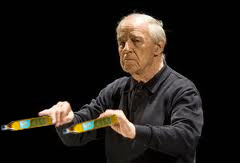Third pressing string quartets?
“If they cut off both hands, I will compose music anyway holding the pen in my teeth,” a determined 30 year-old Shostakovich told a close friend in 1936.
Stalin and his cronies had just walked out of a performance of Shostakovich’s hugely popular opera Lady Macbeth of Mtsensk. Pravda, the official voice of the Union of Soviet Socialist Republics, printed its now infamous article headed “Chaos instead of Music.” Ahead lay a roller-coaster ride as an artist under some of the 20th century’s most oppressive leaders, Stalin and Brezhnev among them.
Shostakovich, of course, continued to compose and MusicTORONTO regulars will be familiar with many of his 15 string quartets. In fact, these days, Shostakovich is an essential part of the repertoire of most string quartets. When the Jerusalem Quartet brings Shostakovich to its much-anticipated MusicTORONTO début October 13, they’ll play him alongside Beethoven.
So how have the Shostakovich quartets won a place at the heart of the string quartet repertoire in the three decades since his death?
The huge span of Shostakovich’s music, over many of the most interesting decades of the last century – from innovative experimentation in a revolutionary young state to uncertain postmodernism in the late symphonies and quartets – may have drawn listeners to the composer.
A 25th anniversary (death) closely followed by a centenary (birth) offered irresistible marketing tools, and added to the momentum.
Then, those of us who were taught by our elders that Shostakovich belonged on the sidelines of musical history – as a foot soldier in the ranks with Hindemith rather than a forward-looking general like a Schoenberg or Stravinsky – had a lot of critical listening to do and received prejudices to shed.
Shostakovich still has his naysayers. Cold-pressed Pierre Boulez likens Shostakovich to a second, or even third, pressing of olive oil.

"Shostakovich plays with clichés most of the time, I find. It's like olive oil, when you have a second and even third pressing, and I think of Shostakovich as the second, or even third, pressing of Mahler."
There’s no explanation for Shostakovich’s continuing popularity in stirring up yesterday’s recipes or tomorrow’s failed culinary trends. Shostakovich confronts the contradictions of daily living in a modern world and we can hear this and identify with it in his music. More survivor than fighter, he reflects both alienation and a sense of belonging; pathos and covert satire. The emotional intensity we intuitively sense in his music clearly belongs within a long tradition of music-making – though Shostakovich inherited little by way of a Russian tradition of string quartet composition upon which to build. The intimate thoughts we sense in many of his quartets are reflected in the dedications he gave to most of them, including two to his wives, and four to members of the string quartet who gave the première of all but the first and the last of the cycle.
Shostakovich learned early on to be cryptic when it came to talking about his music. He left it to others to read such things as ‘optimistic tragedy’ rather than ideological pessimism into his scores. For the performer of his quartets Shostakovich offers few printed interpretative instructions – thereby encouraging freedom in their interpretation. For the listener, only gradually does an overall portrait of a complex human being begin to emerge as each quartet adds one more essential part to a 15-part whole.
Both Shostakovich and Beethoven were late starters when it came to string quartets. But there’s no ‘early period’ in Shostakovich’s quartet catalogue; his first quartet is his Op. 49. Like Beethoven, Shostakovich found solace in the quartet when debilitating illness and a growing isolation intruded on his physical well-being. The ratio of (private) quartets to (public) symphonies reversed with the Sixth quartet that will be played in the MusicTORONTO/JSQ program. There were 5 quartets and 10 symphonies before 1956; 10 quartets and 5 symphonies thereafter. (Shostakovich resisted the public/private characterisation, though, and his late symphonies represent a no less inward journey than the quartets).
The string quartets of both Shostakovich and Beethoven speak of a composer’s triumph over adversity. In both – though with altogether differing results – we can probe deep into the interplay of ideas which underlie the surface message of the music. And that’s a compelling enough reason to continue to draw even greater audiences to this rewarding music.
Jerusalem Quartet. Beethoven/Shostakovich/Brahms. Thursday, October 13, 2011 – 8:00 pm. Jane Mallett Theatre, St. Lawrence Centre for the Arts, 27 Front Street East, Toronto
Also Lafayette Quartet. Wolf/Shostakovich/Brahms. Thursday January 12, 2012 – 8:00 pm. Jane Mallett Theatre, St. Lawrence Centre for the Arts, 27 Front Street East, Toronto
Posted by Keith Horner

Leave a Reply
You must be logged in to post a comment.